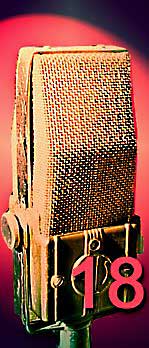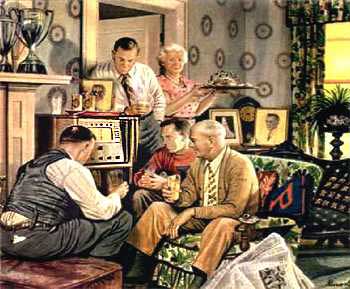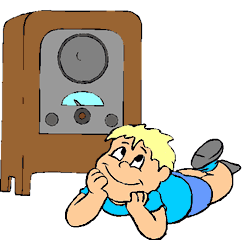Film, Radio and TV - 18 |

The Golden Age
The golden age of radio--the period when radio reached its peak popularity with general audiences--was in the 1930s and 1940s. Strangely, part of this period was during the great depression in North America when people were doing without most luxuries, and even a few necessities. Radio and its wide range of live music, comedy, variety
shows, and dramatic programming served as a welcome escape from the
troubled times. Even though many people couldn't afford payments on
their washing machines, vacuum cleaners, or Model A Fords, they desperately
struggled to keep up payments on their radios. (Keep in mind that
not only were all of these things relatively expensive in the 1930s,
but a large percentage of people were out Note in the drawing on the left that radios of that era weren't just small devices in plastic cases; they were built into large wooden cases that amounted to elaborate pieces of furniture. The large size was due mostly to numerous (rather large) vacuum tubes in the circuitry. It was not until decades later that vacuum tubes were replaced by transistors and integrated circuits. Typically, these early radios also had large speakers that provided rich bass, and large loops of wire wound around an internal drum that served as an adjustable antenna for receiving distant stations. By 1935, more than 22 million American homes had radios, and automobiles were being sold with radios built in (for an extra charge). Except for one very important thing, radio networks, the stage was set for radio's golden era.
Before 1923, radio stations had to produce all of their own programming, which was costly and demanded major resources. (Remember, early radio stations did not depend on recordings; almost most everything was done "live.") But in 1923, two AT&T stations, WEAF and WNAC on the East Coast of the United States, decided they could share the cost of originating certain programs by connecting the two stations with special, high-quality telephone lines, and broadcasting the same program at the same time. Of course, their parent company, AT&T, owned the telephone lines, so that was no real problem. Other stations then joined, and this select group of stations became known as the "telephone group," or more officially, the Broadcasting Corporation of America (BCA). Thus, the concept of the radio network was born. |
This, of course, created a bit of a problem for the radio stations that weren't owned by AT&T. Eventually, the U.S. Justice Department got involved and AT&T sold its BCA radio network and stations to several companies, including RCA. Even so, AT&T maintained its lucrative monopoly on radio network lines. Losing that battle, AT&T then tried to ban the stations they had sold from using their network lines. They were clearly out to control radio one way or another. In response, non-AT&T stations owned by GE, Westinghouse and RCA networked their own stations; but they initially had to use inferior Western Union telegraph lines, which lowered sound quality. The new network became known as the NBC radio network. The stations that carried network programming were (and still are) referred to as affiliates. To join the network radio stations had to sign a contract that required them to carry designated network programs. Since the programs included commercials, the stations received a share of the network revenue. At the same time, the affiliates could run their own local commercials around the network programs. This practice is still followed by both radio and television network affiliates. Then another major player in radio networks emerged, William Paley. Along with NBC President, David Sarnoff, he would become a corporate legend. Paley's father, Sam Paley, owned a cigar company, and William thought that by purchasing the struggling CBS radio network they could better sell their cigars. The CBS radio network, which had just started, was having a hard time competing with NBC. Once he purchased CBS, it wasn't long before William Paley shifted his focus from selling cigars to building a strong rival to NBC. After NBC ran into it's own monopoly problems, it was forced to split its network into two parts: NBC Red and NBC Blue. The latter was then sold to a group of businessmen who renamed it the ABC radio network. Before we get too far ahead in our narrative, there's another radio "war story" we need to cover. When radio stations started broadcasting news, the newspapers yelled "foul," and tried to stop them--or at least badly cripple them. Clearly, radio had a major advantage in being able to "be first with the news" (the motto of more than one radio station). Not only were radio stations scooping them on major stories, but more important to the corporate types, they were siphoning off advertising revenue. The newspapers, which had control of all the major news services, including the Associated Press (AP), the International News Service (INS), and the United Press (UP), launched a corporate war against the radio stations. This was quickly labeled the press-radio war. A photo of a news wire machine (teletype) that was at the center of the controversy is shown on the right. These machines supplied the country's newspapers with regular summaries of news, feature stories, weather forecasts and bulletins. Although the general flow and organization of the news was centrally controlled, individual newspapers could contribute their own stories using the keyboard shown. Recognizing serious competition from the radio stations, the newspapers threatened to cut off their flow of news. Seeing the consequences of that, Paley and CBS set up their own newsgathering agency. That move also represented a threat to the newspapers, so they demanded that CBS totally shut down its newsgathering operations. As if that wasn't enough, the newspapers further said that NBC could only broadcast two, five-minute news summaries a day--and then only after the morning and afternoon newspapers hit the street. But, even that wasn't enough for the newspapers. They further stipulated that the newscasts could not be sponsored, lest the stations cut into newspaper profits. Clearly, the newspaper empire of the day had a lot of power--or at least thought it did. To make a long story short, the radio stations eventually won that battle. Sadly, the radio stations willfully abandoned their victory a few decades later in the favor of increased profits. At that point most radio stations decided that playing music was a lot cheaper than supporting a news staff to find, write, and report news. Today, if radio stations do much news at all, and most don't, it's in the form of reading wire copy rather than actively trying to gather news. But while radio did actively cover news, it did it very well. It did especially well at covering World War II. The most notable radio news personality of that era was Edward R. Morrow. He was an excellent writer and had a deep, dramatic voice. Morrow made you feel as if you were a personal witness to the events that were taking place. He did a live report once from London with the sounds of bombs falling around him. Morrow and others like him during that era had an uncompromising sense of what constitutes legitimate news. They regularly battled with corporate executives who were prone to compromise news standards to protect advertising profits. Unfortunately, in the present era of bottom-line values, this type of courage is now hard to find, which, of course, goes a long way toward explaining why the credibility of mass media news has declined in the past few decades. We'll investigate this further in the modules on newspapers and TV news. But, the Morrow radio era clearly represented the golden age of radio news. Unfortunately, Morrow, who was a chain smoker, died at a relatively young age of lung cancer--the same fate would subsequently befall several other well-known news journalists of that era. Now, back to our story of how this medium could hold families around their radios night after night, and hold women around their radios every weekday afternoon with soap operas (radio dramas that were typically sponsored by soap companies). For one thing, radio in the 1930s wasn't just designed to appeal to specific musical and philosophical tastes as it is today. It was a family medium. Families sat around the radio and listened to shows like "Amos 'n Andy," "Gunsmoke," "The Shadow," "Our Miss Brooks," "Superman," "Ellery Queen, "Dick Tracey," "Buck Rogers," and the "Sixty-Four Dollar Question." (Yes, $64.00 was the top prize!)
There's a one-word answer: imagination. Not being "troubled" by the spelled out details in pictures, the people of the era could and did imagine what the people and situations looked like. For this reason radio was personally involving. Fact is, when some of these shows made the transition to television, they bombed. Audiences were greatly disappointed. The images of the people and surroundings that listeners had held in their minds just couldn't measure up to what they were seeing on TV--especially in those early, blurry, black-and-white pictures. This transition wasn't helped by the fact that some radio personalities, although possessing rich and dramatic voices, didn't photograph well. Once famous radio personality, who weighed close to 300 pounds, had to be replaced on the TV series by someone who sounded quite different. Radio scripts were sprinkled with clues as to what was going on: "Emma, why are you walking over to the cabinet?"; "John, you look very upset."; "I see that you are wearing your bright red dress, Clare." And then there were sound effects--the recorded or created sounds of footsteps, horse's hooves, doors being slammed, rain, thunder, car engines, dogs barking, babies crying, birds singing, fire crackling, etc. In the early days, all of these sound effects were done "live," and radio studios were full of equipment to create just the right effect. There were (scaled down) doors to slam, and telephone bells and door chimes to ring, etc. But, some effects were a bit hard to bring into the studio, and had to be created in other ways. For example, massaging a piece of cellophane next to a microphone created the sound of a crackling fire, and wiggling a large sheet of sheet metal near a microphone created the sound of thunder. Strangely, many of these artificially created effects sounded "more real" than the sound of real thing. In the next module we'll follow the history of radio into two new decades. |
To next module
To index © 1996 - 2005, All Rights Reserved.
|
 of
work.)
of
work.) During the early days of radio AT&T tried to take control of this new medium. It claimed that radio was just a "wireless telephone service," and that meant they should be able to control it.
During the early days of radio AT&T tried to take control of this new medium. It claimed that radio was just a "wireless telephone service," and that meant they should be able to control it.

 Today's listeners, who use radio largely as a background to do other things, might wonder how radio could hold a listener's interest for several hours at a time.
Today's listeners, who use radio largely as a background to do other things, might wonder how radio could hold a listener's interest for several hours at a time.